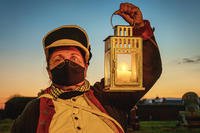As a captain of cavalry in his native Hungary, Charles Zagonyi had participated in the failed Kossuth rebellion of 1848. Arriving in the United States in 1851, he worked variously as a farmhand, tailor, house painter and riding instructor before joining Gen. John C. Fremont's Western Department.
Fremont, also known for his flamboyant behavior, must have appreciated the dashing Continental cavalryman. He appointed Zagonyi to organize and command an elite unit known as the Body Guard or the Jesse Fremont Guard. In keeping with his knowledge and background, then-Maj. Zagonyi outfitted his men splendidly -- in black silk velvet uniforms, according to one account -- and had them equipped and armed with every convenience and gadget.
Zagonyi's moment of glory occurred early in the Civil War. Fremont was determined to avenge the Confederate rout of the Federal arms cache at the Battle of Wilson's Creek. He carefully assembled an army of 40,000 to 50,000 men and advanced toward Springfield, Missouri, from his St. Louis headquarters, hoping to capture Confederate Maj. Gen. Sterling Price. Price retreated to the Ozarks while Fremont camped at the Pomme de Terre River some 50 miles from Springfield. Acting as reconnaissance, Zagonyi's column rode at a furious pace into Springfield on Oct. 25, 1861.
Col. Julian Frazier, the local state guard commander, set up an ambush with 500 Confederate troops near the Mount Vernon Road west of the city. When Zagonyi's force charged down that road at 3 p.m., it encountered fire from both sides but galloped on to Jordan Creek. There, the soldiers wheeled around in a ferocious counterattack. Frazier's Confederates fled.
Though outnumbered 10 to one, Zagonyi's crack corps of 300 proceeded into the town center, where they released federal prisoners and caused a wild demonstration in the square. Conscious that his troops might face a Confederate counterattack, the daring former hussar left Springfield before nightfall and returned to his superior's camp.
Fremont later compared Zagonyi's feat to the famous Crimean War charge of the British Light Brigade -- which, by coincidence, occurred on Oct. 25, 1854, during the Battle of Balaklava. But Zagonyi's feat is no longer so well-known, possibly because Fremont was relieved for issuing an emancipation proclamation for Missouri shortly after the "Zagonyi Death Ride."
As for Zagonyi, he soon rode into obscurity. Nothing is known of his career or whereabouts after 1867.
Want to Know More About the Military?
Be sure to get the latest news about the U.S. military, as well as critical info about how to join and all the benefits of service. Subscribe to Military.com and receive customized updates delivered straight to your inbox.















